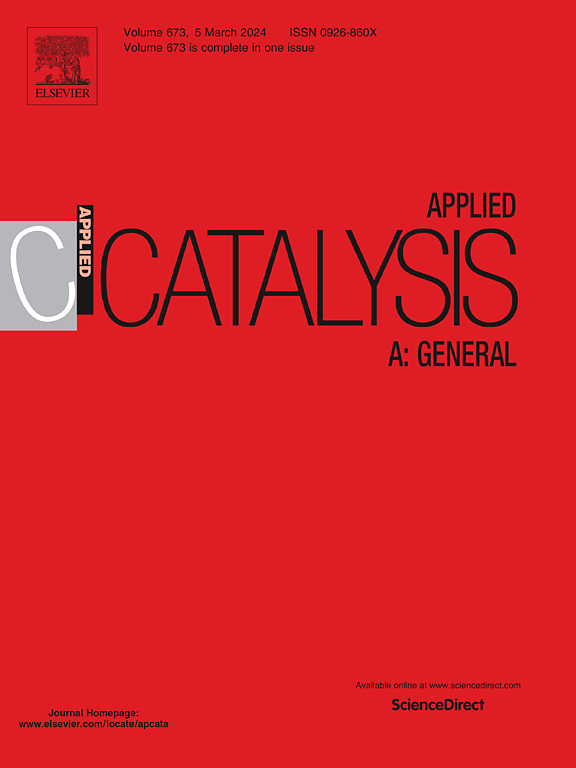在MTO过程中优化SAPO-34催化剂的表面电位电荷调制和顺序蚀刻策略:对催化性能的机理见解
IF 4.8
2区 化学
Q2 CHEMISTRY, PHYSICAL
引用次数: 0
摘要
SAPO-34催化剂上甲醇制烯烃(MTO)过程受表面电位电荷的显著影响,影响甲醇吸附、中间溢出和焦炭的形成。以未改性的SAPO-34 (SP34-P)为对照,研究了经过酸性(SP34-A)、碱性(SP34-B)和顺序酸碱(SP34-AB)蚀刻改性的SAPO-34催化剂的催化性能和机理行为。通过分子动力学(MD)模拟、NH3-TPD酸度测量和zeta电位分析,研究了表面电位电荷对催化剂性能的影响。结果表明,高负电荷(SP34-A, - 67 mV)增强了甲醇吸附,但限制了外溢效率,促进了甲醛积累,增加了焦炭沉积,最终降低了催化剂的寿命。相反,表面带正电荷(SP34-B, +22 mV)增强了外溢,调节了吸附强度,减少了焦炭的形成,延长了催化剂的稳定性。顺序酸碱蚀刻催化剂(SP34-AB, +16.9 mV)实现了良好的表面电荷平衡,优化了甲醇的吸附、溢出行为和扩散效率。这种平衡最大限度地减少了二次反应,延长了催化剂寿命(586 min,比SP34-P长1.63倍),并提高了轻烯烃选择性(88.82 %),表明SP34-AB具有优越的催化性能。结构和结构分析进一步证实,通过连续蚀刻引起的分层孔隙增强了传质,减轻了扩散限制,防止了过多的焦炭形成。这些发现确定了表面电位电荷是SAPO-34催化剂设计的关键参数,强调了顺序酸碱蚀刻是提高MTO效率和催化剂寿命的有效改性策略。本文章由计算机程序翻译,如有差异,请以英文原文为准。
Surface potential charge modulation and sequential etching strategies for optimizing SAPO-34 catalysts in the MTO process: Mechanistic insights into catalytic performance
The methanol-to-olefins (MTO) process over SAPO-34 catalysts is significantly influenced by surface potential charge, affecting methanol adsorption, intermediate spillover, and coke formation. This study investigates the catalytic performance and mechanistic behavior of SAPO-34 catalysts modified through acidic (SP34-A), basic (SP34-B), and sequential acid-base (SP34-AB) etching, with the unmodified SAPO-34 (SP34-P) serving as a reference. The impact of surface potential charge on catalyst performance was examined using molecular dynamics (MD) simulations, NH3-TPD acidity measurements, and zeta potential analysis. The results reveal that a highly negative surface charge (SP34-A, −67 mV) intensifies methanol adsorption but limits spillover efficiency, promoting formaldehyde accumulation and increasing coke deposition, ultimately reducing catalyst lifetime. In contrast, a positive surface charge (SP34-B, +22 mV) enhances spillover and moderates adsorption strength, reducing coke formation and extending catalyst stability. The sequential acid-base etched catalyst (SP34-AB, +16.9 mV) achieves a well-balanced surface charge, optimizing methanol adsorption, spillover behavior, and diffusion efficiency. This balance minimizes secondary reactions, extends catalyst lifetime (586 min, 1.63 times longer than SP34-P), and improves light olefin selectivity (88.82 %), demonstrating the superior catalytic performance of SP34-AB. Structural and textural analysis further confirms that hierarchical porosity, induced via sequential etching, enhances mass transfer and mitigates diffusion limitations, preventing excessive coke formation. These findings establish surface potential charge as a critical parameter in SAPO-34 catalyst design, highlighting sequential acid-base etching as an effective modification strategy to enhance MTO efficiency and catalyst longevity.
求助全文
通过发布文献求助,成功后即可免费获取论文全文。
去求助
来源期刊

Applied Catalysis A: General
化学-环境科学
CiteScore
9.00
自引率
5.50%
发文量
415
审稿时长
24 days
期刊介绍:
Applied Catalysis A: General publishes original papers on all aspects of catalysis of basic and practical interest to chemical scientists in both industrial and academic fields, with an emphasis onnew understanding of catalysts and catalytic reactions, new catalytic materials, new techniques, and new processes, especially those that have potential practical implications.
Papers that report results of a thorough study or optimization of systems or processes that are well understood, widely studied, or minor variations of known ones are discouraged. Authors should include statements in a separate section "Justification for Publication" of how the manuscript fits the scope of the journal in the cover letter to the editors. Submissions without such justification will be rejected without review.
 求助内容:
求助内容: 应助结果提醒方式:
应助结果提醒方式:


